BIZ201 Accounting: Financial Analysis & Crystal Hotel Performance
VerifiedAdded on 2023/06/08
|10
|1945
|280
Case Study
AI Summary
This case study presents a comprehensive financial analysis of Crystal Hotel Pty Ltd, a privately-owned three-star hotel in Sydney. The analysis involves a comparative assessment of the hotel's income statement against industry benchmarks, revealing strengths in room revenue but weaknesses in food and beverage revenue and cost of sales. Ratio analysis is employed to evaluate profitability, efficiency, liquidity, and solvency, highlighting areas where the hotel underperforms compared to industry averages, particularly in efficiency and liquidity. The study also examines industry-specific benchmarks such as room pricing, employee turnover, and credit policies, concluding that Crystal Hotel needs to improve its financial situation across various aspects to enhance its overall position and competitiveness. The report emphasizes the importance of controlling expenses, increasing revenue, and optimizing capital structure to achieve industry benchmarks.
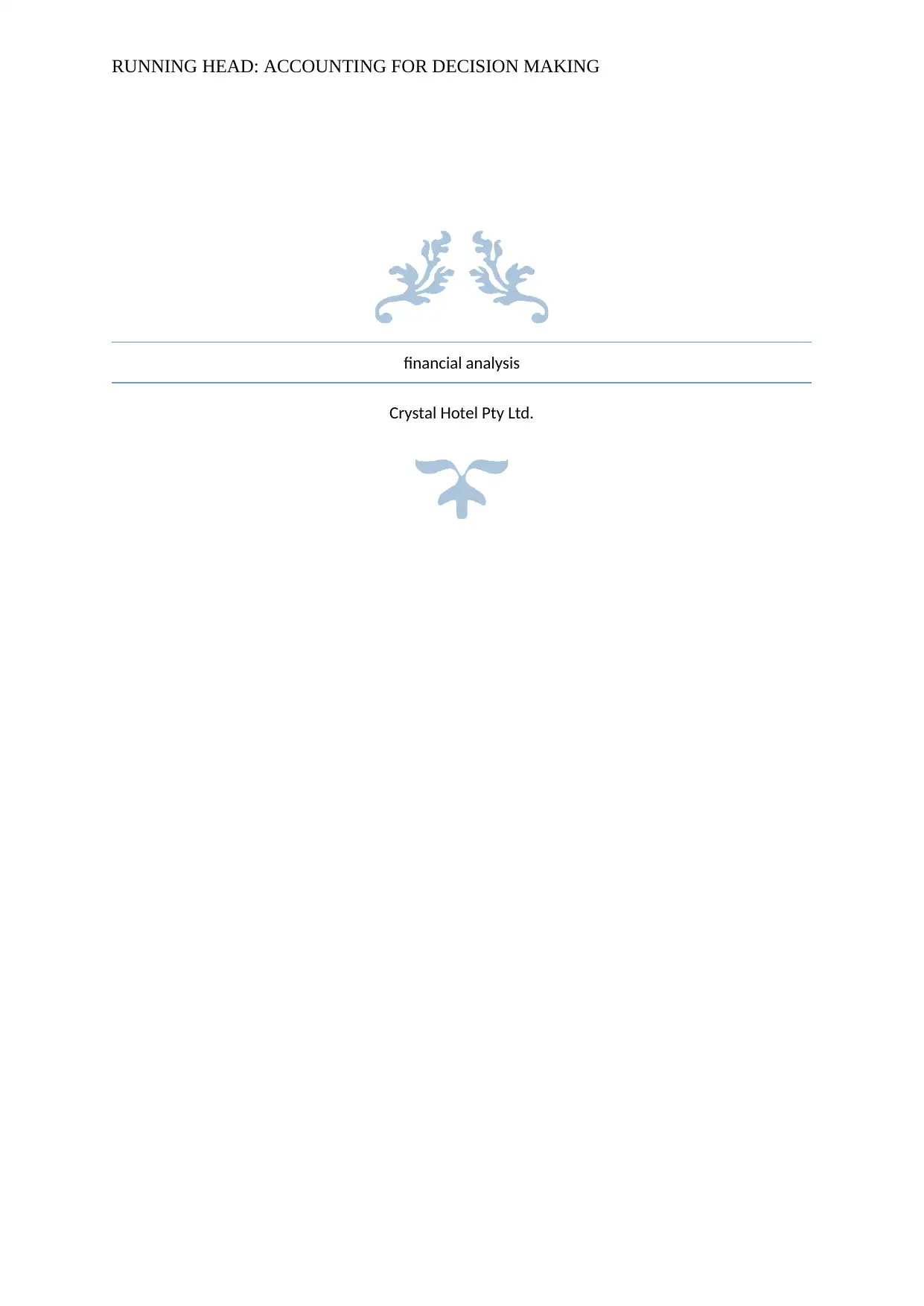
RUNNING HEAD: ACCOUNTING FOR DECISION MAKING
financial analysis
Crystal Hotel Pty Ltd.
financial analysis
Crystal Hotel Pty Ltd.
Paraphrase This Document
Need a fresh take? Get an instant paraphrase of this document with our AI Paraphraser
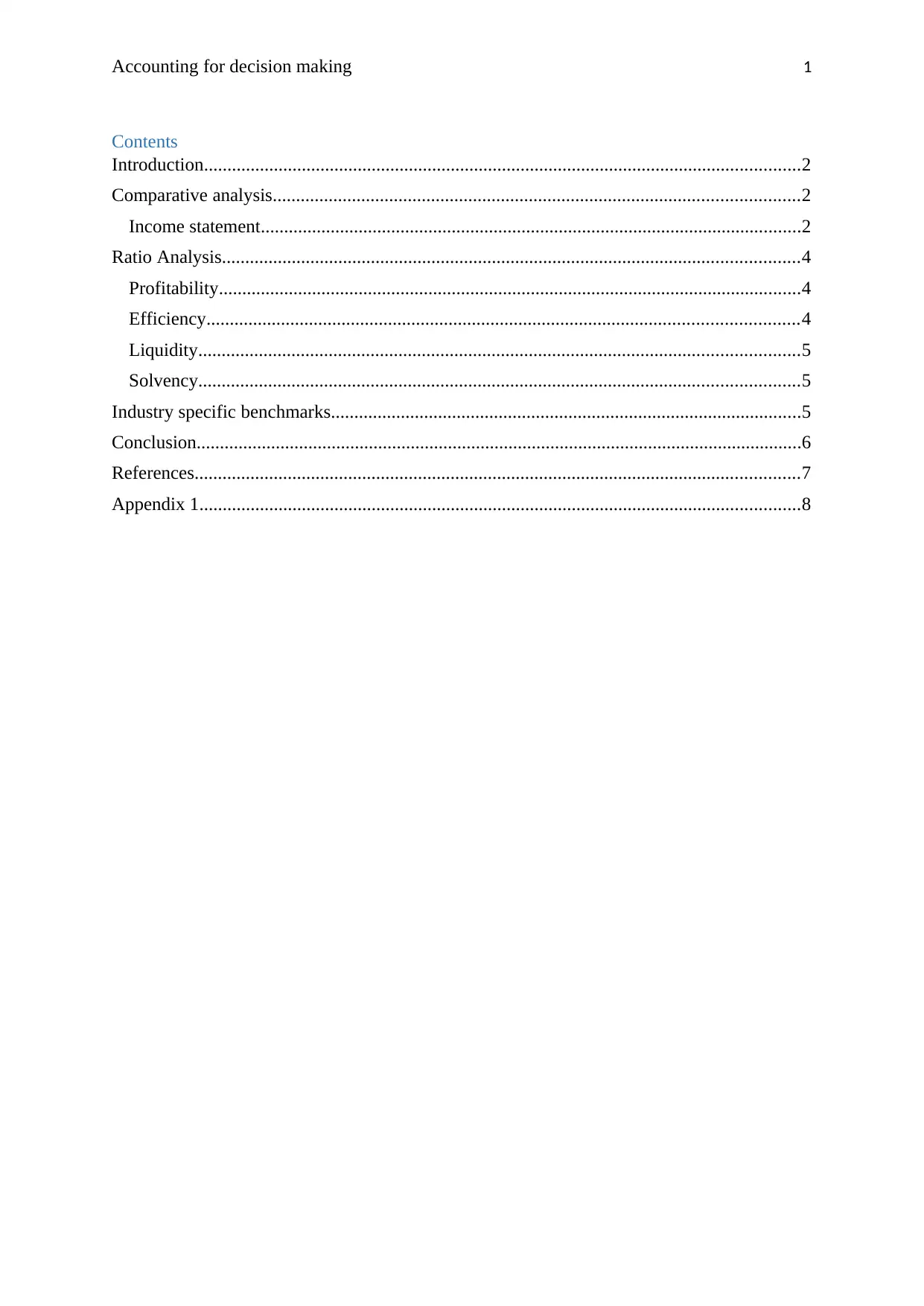
Accounting for decision making 1
Contents
Introduction................................................................................................................................2
Comparative analysis.................................................................................................................2
Income statement....................................................................................................................2
Ratio Analysis............................................................................................................................4
Profitability.............................................................................................................................4
Efficiency...............................................................................................................................4
Liquidity.................................................................................................................................5
Solvency.................................................................................................................................5
Industry specific benchmarks.....................................................................................................5
Conclusion..................................................................................................................................6
References..................................................................................................................................7
Appendix 1.................................................................................................................................8
Contents
Introduction................................................................................................................................2
Comparative analysis.................................................................................................................2
Income statement....................................................................................................................2
Ratio Analysis............................................................................................................................4
Profitability.............................................................................................................................4
Efficiency...............................................................................................................................4
Liquidity.................................................................................................................................5
Solvency.................................................................................................................................5
Industry specific benchmarks.....................................................................................................5
Conclusion..................................................................................................................................6
References..................................................................................................................................7
Appendix 1.................................................................................................................................8

Accounting for decision making 2
Introduction
Financial statement analysis is a process of examining and evaluating the statements prepared
by the companies that reflect their financial data. It helps in measuring the profitability of the
business and its ability to continue for long run. The analysis include assessment of the
financial data presented in the annual report by using some techniques or methods. These are
horizontal and vertical analysis. Ratio and trend analysis and many more (Hussey, 2011).
This report contains a financial analysis of Crystal Hotel Pty Ltd including the evaluation of
its balance sheet and income statement.
Crystal Hotel is privately owned three start hotel situated at Paramatta CBD in Sydney. It
consists of some 160 rooms, a restaurant, a function and a conference room with the average
price per room per night of $148. The hotel provides best hospitality services to its customers
but is facing many problems in maintaining its profits. Most of the revenue of the hotel
derives from its corporate clientele who make payments on credit terms due to their long term
contracts. Moreover, it is becoming very difficult for the firm to maintain good staff. So in
order to deal with all such issues, a proper analysis of financial statements is been done so as
to identify the area of improvement.
Comparative analysis
Income statement
The statement of financial performance is prepared in order to calculate the amount of profit
earned by the company during a particular financial year. Analysis of the same gives an idea
about the profitability of the concern and the net income generated by it after considering all
the expenses. Vertical analysis identifies the relationship between the various elements of the
statement. On income statement, total revenue is been represented as a basis for calculating
Introduction
Financial statement analysis is a process of examining and evaluating the statements prepared
by the companies that reflect their financial data. It helps in measuring the profitability of the
business and its ability to continue for long run. The analysis include assessment of the
financial data presented in the annual report by using some techniques or methods. These are
horizontal and vertical analysis. Ratio and trend analysis and many more (Hussey, 2011).
This report contains a financial analysis of Crystal Hotel Pty Ltd including the evaluation of
its balance sheet and income statement.
Crystal Hotel is privately owned three start hotel situated at Paramatta CBD in Sydney. It
consists of some 160 rooms, a restaurant, a function and a conference room with the average
price per room per night of $148. The hotel provides best hospitality services to its customers
but is facing many problems in maintaining its profits. Most of the revenue of the hotel
derives from its corporate clientele who make payments on credit terms due to their long term
contracts. Moreover, it is becoming very difficult for the firm to maintain good staff. So in
order to deal with all such issues, a proper analysis of financial statements is been done so as
to identify the area of improvement.
Comparative analysis
Income statement
The statement of financial performance is prepared in order to calculate the amount of profit
earned by the company during a particular financial year. Analysis of the same gives an idea
about the profitability of the concern and the net income generated by it after considering all
the expenses. Vertical analysis identifies the relationship between the various elements of the
statement. On income statement, total revenue is been represented as a basis for calculating
⊘ This is a preview!⊘
Do you want full access?
Subscribe today to unlock all pages.

Trusted by 1+ million students worldwide
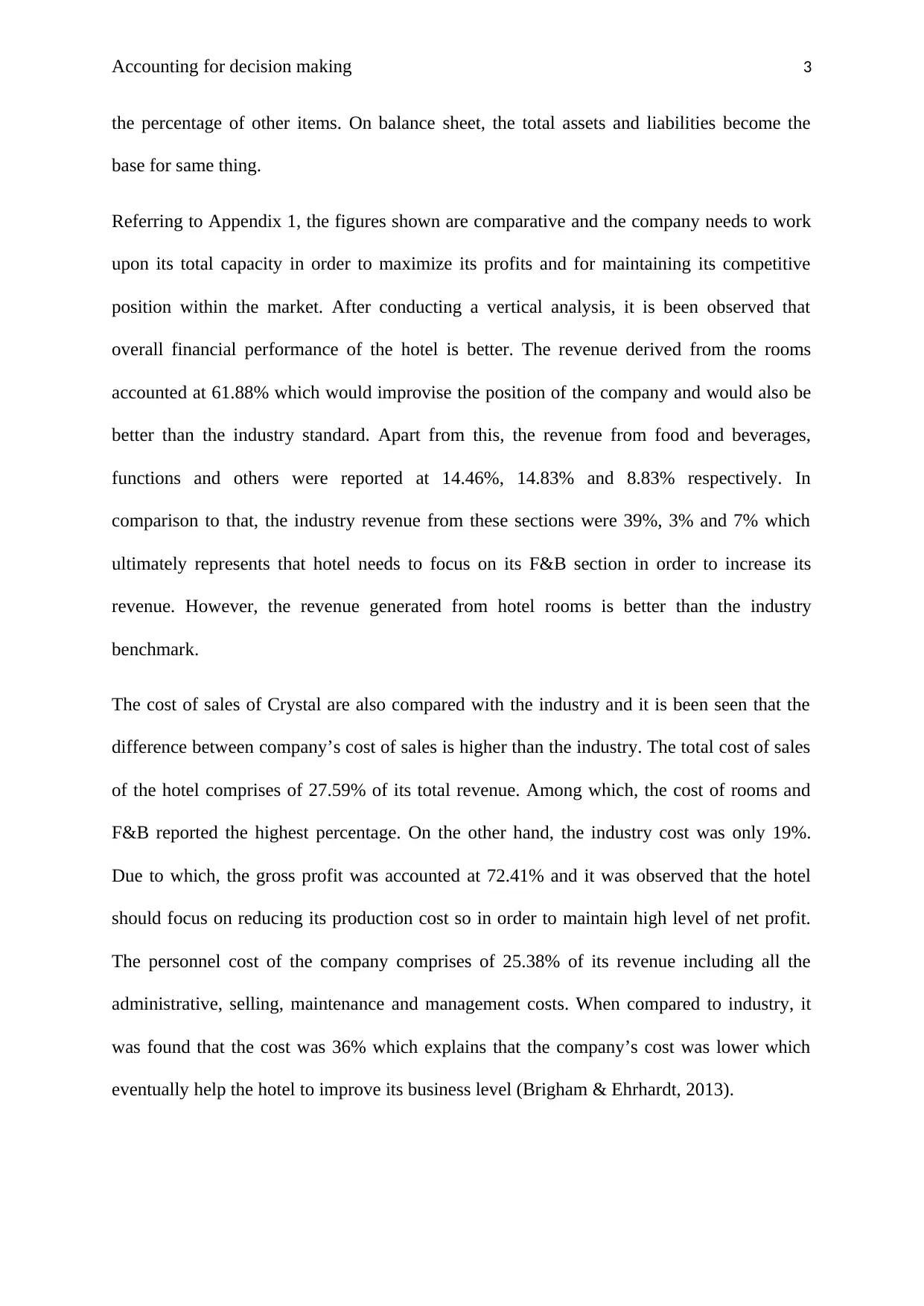
Accounting for decision making 3
the percentage of other items. On balance sheet, the total assets and liabilities become the
base for same thing.
Referring to Appendix 1, the figures shown are comparative and the company needs to work
upon its total capacity in order to maximize its profits and for maintaining its competitive
position within the market. After conducting a vertical analysis, it is been observed that
overall financial performance of the hotel is better. The revenue derived from the rooms
accounted at 61.88% which would improvise the position of the company and would also be
better than the industry standard. Apart from this, the revenue from food and beverages,
functions and others were reported at 14.46%, 14.83% and 8.83% respectively. In
comparison to that, the industry revenue from these sections were 39%, 3% and 7% which
ultimately represents that hotel needs to focus on its F&B section in order to increase its
revenue. However, the revenue generated from hotel rooms is better than the industry
benchmark.
The cost of sales of Crystal are also compared with the industry and it is been seen that the
difference between company’s cost of sales is higher than the industry. The total cost of sales
of the hotel comprises of 27.59% of its total revenue. Among which, the cost of rooms and
F&B reported the highest percentage. On the other hand, the industry cost was only 19%.
Due to which, the gross profit was accounted at 72.41% and it was observed that the hotel
should focus on reducing its production cost so in order to maintain high level of net profit.
The personnel cost of the company comprises of 25.38% of its revenue including all the
administrative, selling, maintenance and management costs. When compared to industry, it
was found that the cost was 36% which explains that the company’s cost was lower which
eventually help the hotel to improve its business level (Brigham & Ehrhardt, 2013).
the percentage of other items. On balance sheet, the total assets and liabilities become the
base for same thing.
Referring to Appendix 1, the figures shown are comparative and the company needs to work
upon its total capacity in order to maximize its profits and for maintaining its competitive
position within the market. After conducting a vertical analysis, it is been observed that
overall financial performance of the hotel is better. The revenue derived from the rooms
accounted at 61.88% which would improvise the position of the company and would also be
better than the industry standard. Apart from this, the revenue from food and beverages,
functions and others were reported at 14.46%, 14.83% and 8.83% respectively. In
comparison to that, the industry revenue from these sections were 39%, 3% and 7% which
ultimately represents that hotel needs to focus on its F&B section in order to increase its
revenue. However, the revenue generated from hotel rooms is better than the industry
benchmark.
The cost of sales of Crystal are also compared with the industry and it is been seen that the
difference between company’s cost of sales is higher than the industry. The total cost of sales
of the hotel comprises of 27.59% of its total revenue. Among which, the cost of rooms and
F&B reported the highest percentage. On the other hand, the industry cost was only 19%.
Due to which, the gross profit was accounted at 72.41% and it was observed that the hotel
should focus on reducing its production cost so in order to maintain high level of net profit.
The personnel cost of the company comprises of 25.38% of its revenue including all the
administrative, selling, maintenance and management costs. When compared to industry, it
was found that the cost was 36% which explains that the company’s cost was lower which
eventually help the hotel to improve its business level (Brigham & Ehrhardt, 2013).
Paraphrase This Document
Need a fresh take? Get an instant paraphrase of this document with our AI Paraphraser
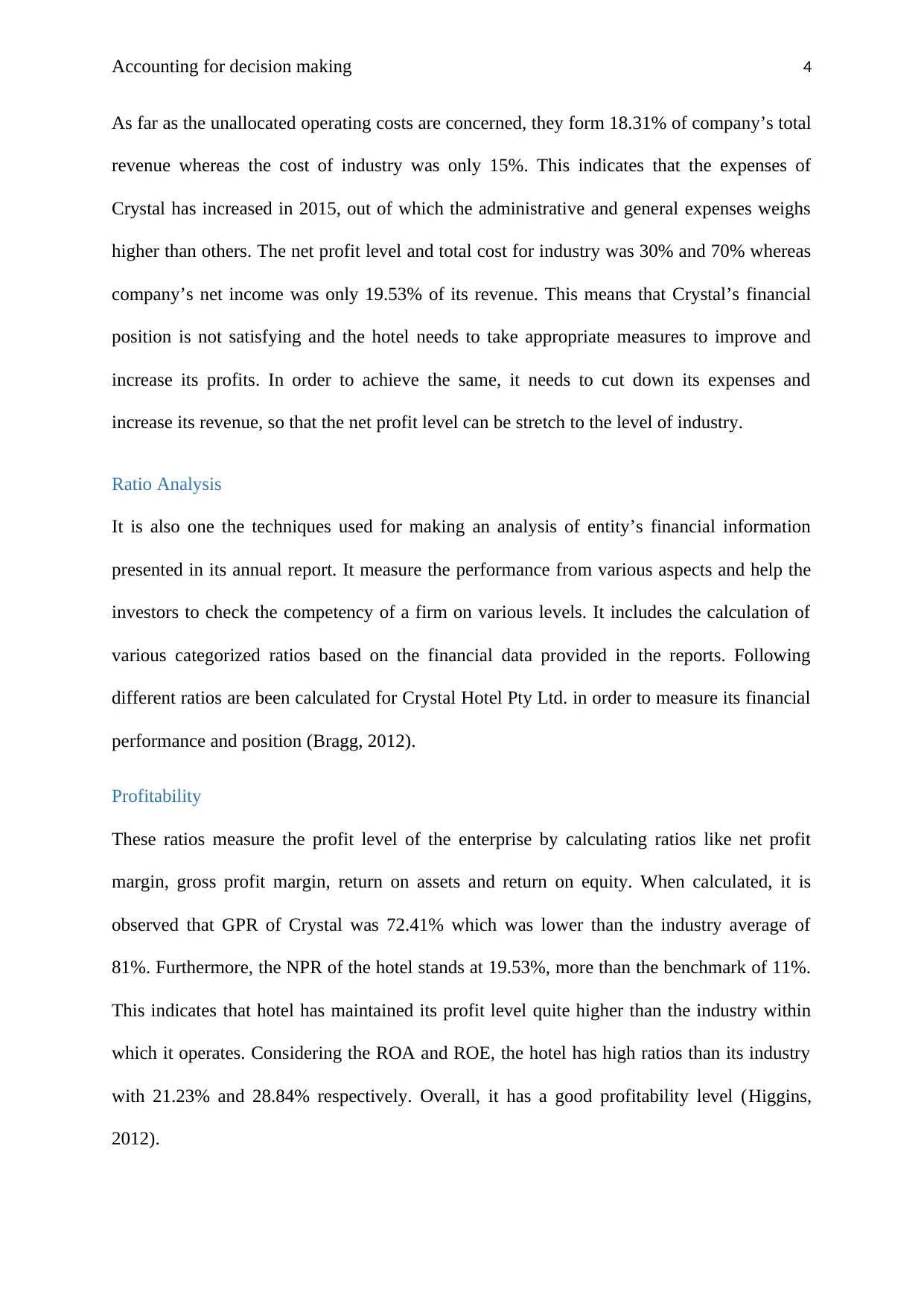
Accounting for decision making 4
As far as the unallocated operating costs are concerned, they form 18.31% of company’s total
revenue whereas the cost of industry was only 15%. This indicates that the expenses of
Crystal has increased in 2015, out of which the administrative and general expenses weighs
higher than others. The net profit level and total cost for industry was 30% and 70% whereas
company’s net income was only 19.53% of its revenue. This means that Crystal’s financial
position is not satisfying and the hotel needs to take appropriate measures to improve and
increase its profits. In order to achieve the same, it needs to cut down its expenses and
increase its revenue, so that the net profit level can be stretch to the level of industry.
Ratio Analysis
It is also one the techniques used for making an analysis of entity’s financial information
presented in its annual report. It measure the performance from various aspects and help the
investors to check the competency of a firm on various levels. It includes the calculation of
various categorized ratios based on the financial data provided in the reports. Following
different ratios are been calculated for Crystal Hotel Pty Ltd. in order to measure its financial
performance and position (Bragg, 2012).
Profitability
These ratios measure the profit level of the enterprise by calculating ratios like net profit
margin, gross profit margin, return on assets and return on equity. When calculated, it is
observed that GPR of Crystal was 72.41% which was lower than the industry average of
81%. Furthermore, the NPR of the hotel stands at 19.53%, more than the benchmark of 11%.
This indicates that hotel has maintained its profit level quite higher than the industry within
which it operates. Considering the ROA and ROE, the hotel has high ratios than its industry
with 21.23% and 28.84% respectively. Overall, it has a good profitability level (Higgins,
2012).
As far as the unallocated operating costs are concerned, they form 18.31% of company’s total
revenue whereas the cost of industry was only 15%. This indicates that the expenses of
Crystal has increased in 2015, out of which the administrative and general expenses weighs
higher than others. The net profit level and total cost for industry was 30% and 70% whereas
company’s net income was only 19.53% of its revenue. This means that Crystal’s financial
position is not satisfying and the hotel needs to take appropriate measures to improve and
increase its profits. In order to achieve the same, it needs to cut down its expenses and
increase its revenue, so that the net profit level can be stretch to the level of industry.
Ratio Analysis
It is also one the techniques used for making an analysis of entity’s financial information
presented in its annual report. It measure the performance from various aspects and help the
investors to check the competency of a firm on various levels. It includes the calculation of
various categorized ratios based on the financial data provided in the reports. Following
different ratios are been calculated for Crystal Hotel Pty Ltd. in order to measure its financial
performance and position (Bragg, 2012).
Profitability
These ratios measure the profit level of the enterprise by calculating ratios like net profit
margin, gross profit margin, return on assets and return on equity. When calculated, it is
observed that GPR of Crystal was 72.41% which was lower than the industry average of
81%. Furthermore, the NPR of the hotel stands at 19.53%, more than the benchmark of 11%.
This indicates that hotel has maintained its profit level quite higher than the industry within
which it operates. Considering the ROA and ROE, the hotel has high ratios than its industry
with 21.23% and 28.84% respectively. Overall, it has a good profitability level (Higgins,
2012).
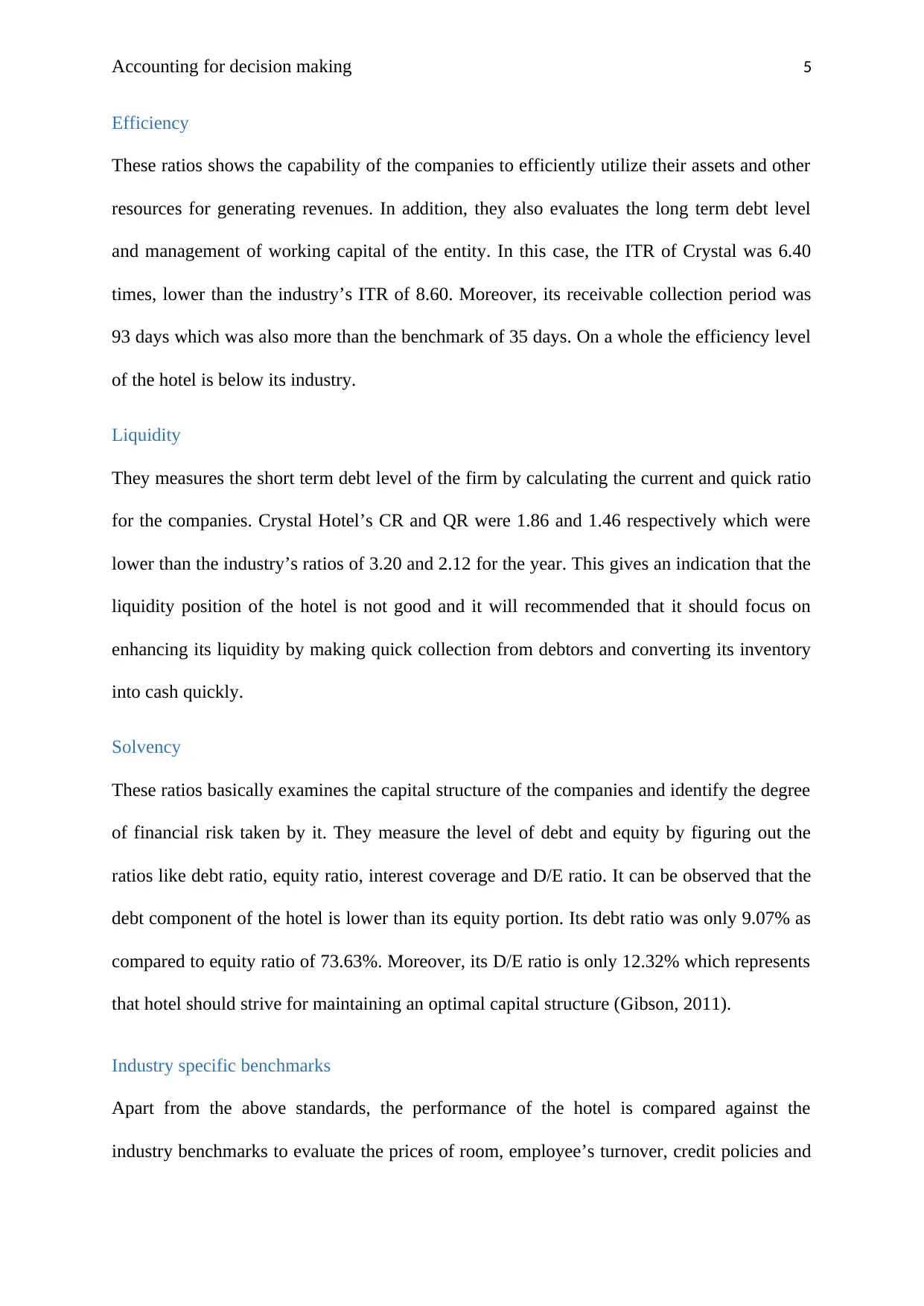
Accounting for decision making 5
Efficiency
These ratios shows the capability of the companies to efficiently utilize their assets and other
resources for generating revenues. In addition, they also evaluates the long term debt level
and management of working capital of the entity. In this case, the ITR of Crystal was 6.40
times, lower than the industry’s ITR of 8.60. Moreover, its receivable collection period was
93 days which was also more than the benchmark of 35 days. On a whole the efficiency level
of the hotel is below its industry.
Liquidity
They measures the short term debt level of the firm by calculating the current and quick ratio
for the companies. Crystal Hotel’s CR and QR were 1.86 and 1.46 respectively which were
lower than the industry’s ratios of 3.20 and 2.12 for the year. This gives an indication that the
liquidity position of the hotel is not good and it will recommended that it should focus on
enhancing its liquidity by making quick collection from debtors and converting its inventory
into cash quickly.
Solvency
These ratios basically examines the capital structure of the companies and identify the degree
of financial risk taken by it. They measure the level of debt and equity by figuring out the
ratios like debt ratio, equity ratio, interest coverage and D/E ratio. It can be observed that the
debt component of the hotel is lower than its equity portion. Its debt ratio was only 9.07% as
compared to equity ratio of 73.63%. Moreover, its D/E ratio is only 12.32% which represents
that hotel should strive for maintaining an optimal capital structure (Gibson, 2011).
Industry specific benchmarks
Apart from the above standards, the performance of the hotel is compared against the
industry benchmarks to evaluate the prices of room, employee’s turnover, credit policies and
Efficiency
These ratios shows the capability of the companies to efficiently utilize their assets and other
resources for generating revenues. In addition, they also evaluates the long term debt level
and management of working capital of the entity. In this case, the ITR of Crystal was 6.40
times, lower than the industry’s ITR of 8.60. Moreover, its receivable collection period was
93 days which was also more than the benchmark of 35 days. On a whole the efficiency level
of the hotel is below its industry.
Liquidity
They measures the short term debt level of the firm by calculating the current and quick ratio
for the companies. Crystal Hotel’s CR and QR were 1.86 and 1.46 respectively which were
lower than the industry’s ratios of 3.20 and 2.12 for the year. This gives an indication that the
liquidity position of the hotel is not good and it will recommended that it should focus on
enhancing its liquidity by making quick collection from debtors and converting its inventory
into cash quickly.
Solvency
These ratios basically examines the capital structure of the companies and identify the degree
of financial risk taken by it. They measure the level of debt and equity by figuring out the
ratios like debt ratio, equity ratio, interest coverage and D/E ratio. It can be observed that the
debt component of the hotel is lower than its equity portion. Its debt ratio was only 9.07% as
compared to equity ratio of 73.63%. Moreover, its D/E ratio is only 12.32% which represents
that hotel should strive for maintaining an optimal capital structure (Gibson, 2011).
Industry specific benchmarks
Apart from the above standards, the performance of the hotel is compared against the
industry benchmarks to evaluate the prices of room, employee’s turnover, credit policies and
⊘ This is a preview!⊘
Do you want full access?
Subscribe today to unlock all pages.

Trusted by 1+ million students worldwide
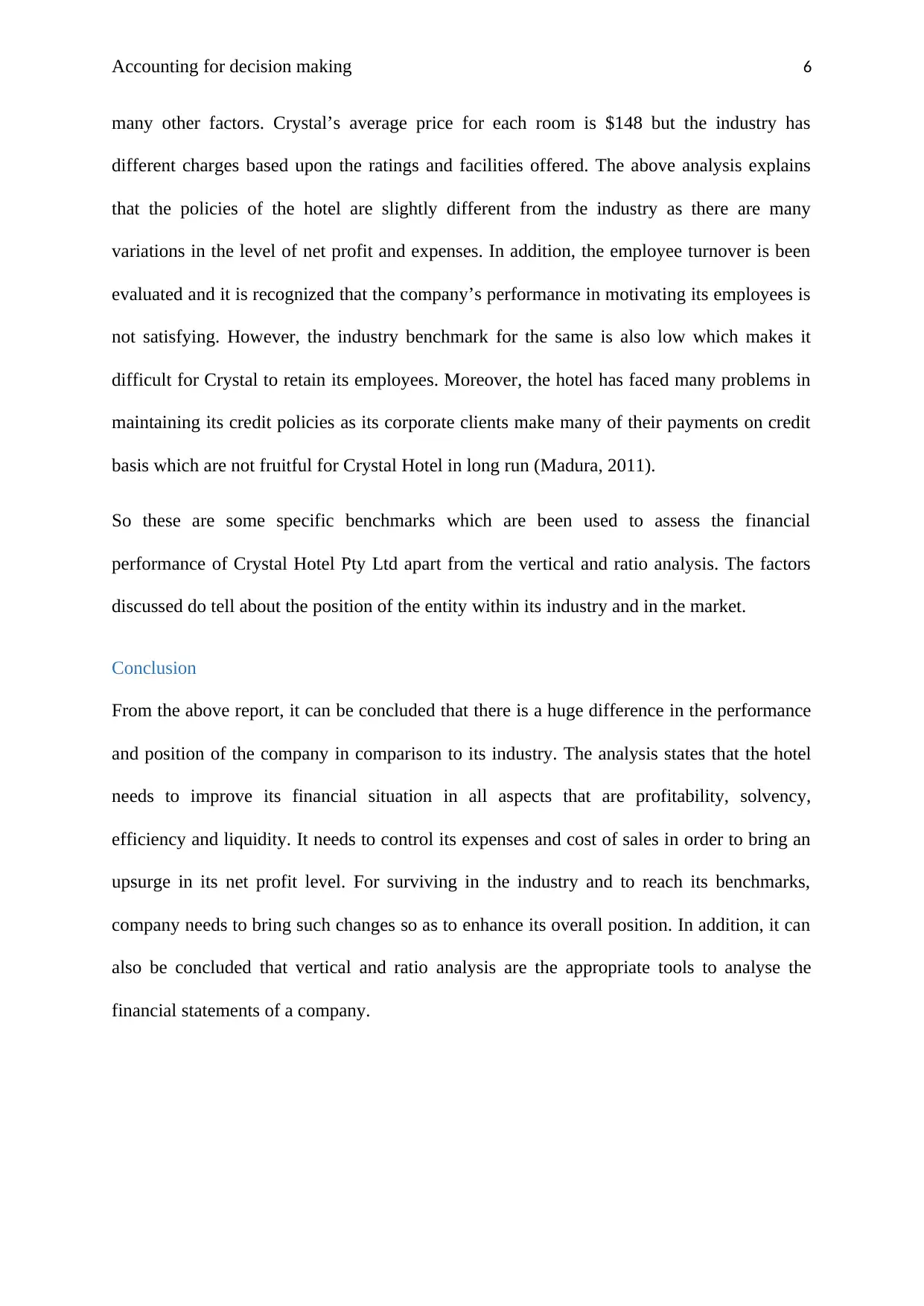
Accounting for decision making 6
many other factors. Crystal’s average price for each room is $148 but the industry has
different charges based upon the ratings and facilities offered. The above analysis explains
that the policies of the hotel are slightly different from the industry as there are many
variations in the level of net profit and expenses. In addition, the employee turnover is been
evaluated and it is recognized that the company’s performance in motivating its employees is
not satisfying. However, the industry benchmark for the same is also low which makes it
difficult for Crystal to retain its employees. Moreover, the hotel has faced many problems in
maintaining its credit policies as its corporate clients make many of their payments on credit
basis which are not fruitful for Crystal Hotel in long run (Madura, 2011).
So these are some specific benchmarks which are been used to assess the financial
performance of Crystal Hotel Pty Ltd apart from the vertical and ratio analysis. The factors
discussed do tell about the position of the entity within its industry and in the market.
Conclusion
From the above report, it can be concluded that there is a huge difference in the performance
and position of the company in comparison to its industry. The analysis states that the hotel
needs to improve its financial situation in all aspects that are profitability, solvency,
efficiency and liquidity. It needs to control its expenses and cost of sales in order to bring an
upsurge in its net profit level. For surviving in the industry and to reach its benchmarks,
company needs to bring such changes so as to enhance its overall position. In addition, it can
also be concluded that vertical and ratio analysis are the appropriate tools to analyse the
financial statements of a company.
many other factors. Crystal’s average price for each room is $148 but the industry has
different charges based upon the ratings and facilities offered. The above analysis explains
that the policies of the hotel are slightly different from the industry as there are many
variations in the level of net profit and expenses. In addition, the employee turnover is been
evaluated and it is recognized that the company’s performance in motivating its employees is
not satisfying. However, the industry benchmark for the same is also low which makes it
difficult for Crystal to retain its employees. Moreover, the hotel has faced many problems in
maintaining its credit policies as its corporate clients make many of their payments on credit
basis which are not fruitful for Crystal Hotel in long run (Madura, 2011).
So these are some specific benchmarks which are been used to assess the financial
performance of Crystal Hotel Pty Ltd apart from the vertical and ratio analysis. The factors
discussed do tell about the position of the entity within its industry and in the market.
Conclusion
From the above report, it can be concluded that there is a huge difference in the performance
and position of the company in comparison to its industry. The analysis states that the hotel
needs to improve its financial situation in all aspects that are profitability, solvency,
efficiency and liquidity. It needs to control its expenses and cost of sales in order to bring an
upsurge in its net profit level. For surviving in the industry and to reach its benchmarks,
company needs to bring such changes so as to enhance its overall position. In addition, it can
also be concluded that vertical and ratio analysis are the appropriate tools to analyse the
financial statements of a company.
Paraphrase This Document
Need a fresh take? Get an instant paraphrase of this document with our AI Paraphraser
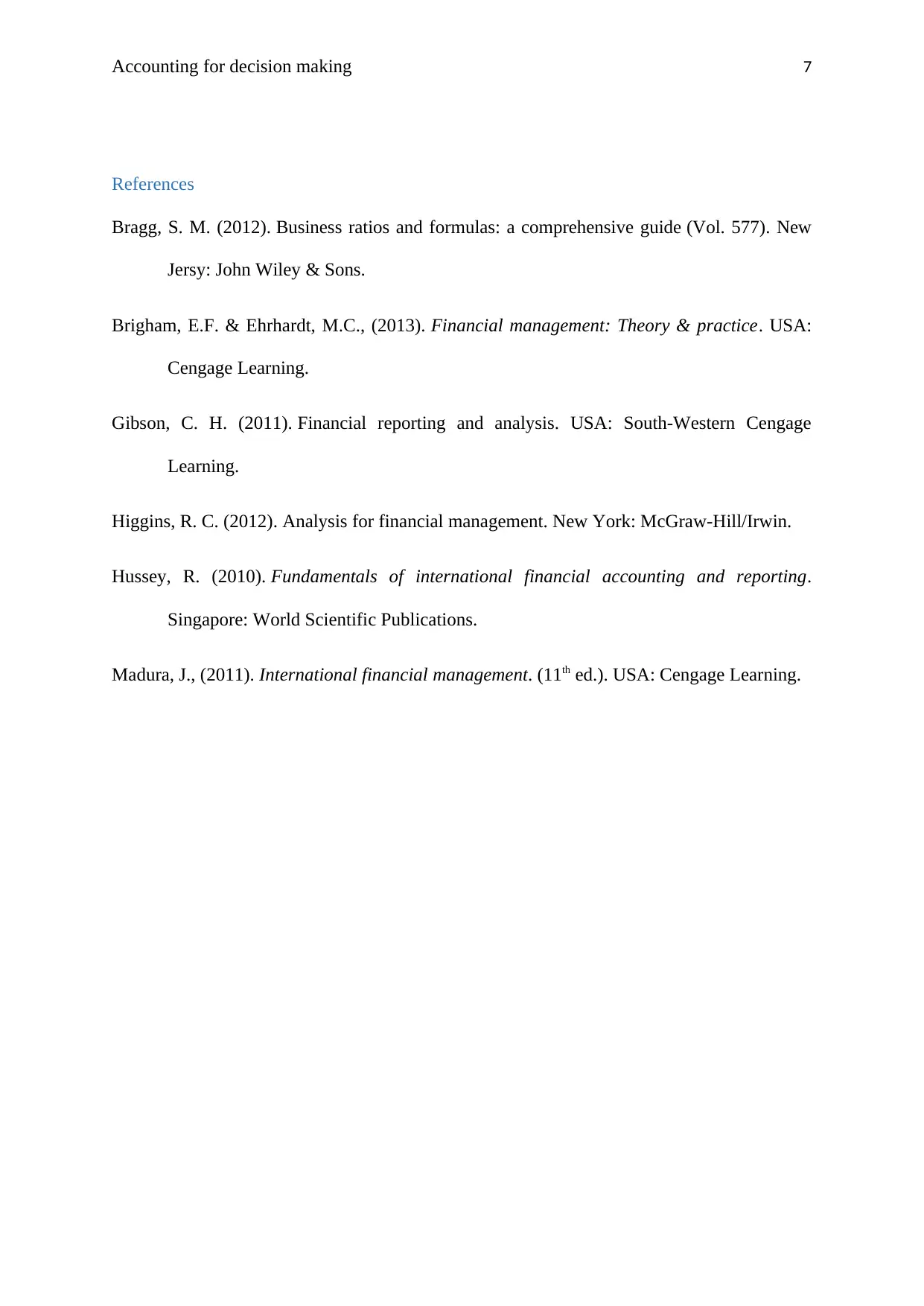
Accounting for decision making 7
References
Bragg, S. M. (2012). Business ratios and formulas: a comprehensive guide (Vol. 577). New
Jersy: John Wiley & Sons.
Brigham, E.F. & Ehrhardt, M.C., (2013). Financial management: Theory & practice. USA:
Cengage Learning.
Gibson, C. H. (2011). Financial reporting and analysis. USA: South-Western Cengage
Learning.
Higgins, R. C. (2012). Analysis for financial management. New York: McGraw-Hill/Irwin.
Hussey, R. (2010). Fundamentals of international financial accounting and reporting.
Singapore: World Scientific Publications.
Madura, J., (2011). International financial management. (11th ed.). USA: Cengage Learning.
References
Bragg, S. M. (2012). Business ratios and formulas: a comprehensive guide (Vol. 577). New
Jersy: John Wiley & Sons.
Brigham, E.F. & Ehrhardt, M.C., (2013). Financial management: Theory & practice. USA:
Cengage Learning.
Gibson, C. H. (2011). Financial reporting and analysis. USA: South-Western Cengage
Learning.
Higgins, R. C. (2012). Analysis for financial management. New York: McGraw-Hill/Irwin.
Hussey, R. (2010). Fundamentals of international financial accounting and reporting.
Singapore: World Scientific Publications.
Madura, J., (2011). International financial management. (11th ed.). USA: Cengage Learning.
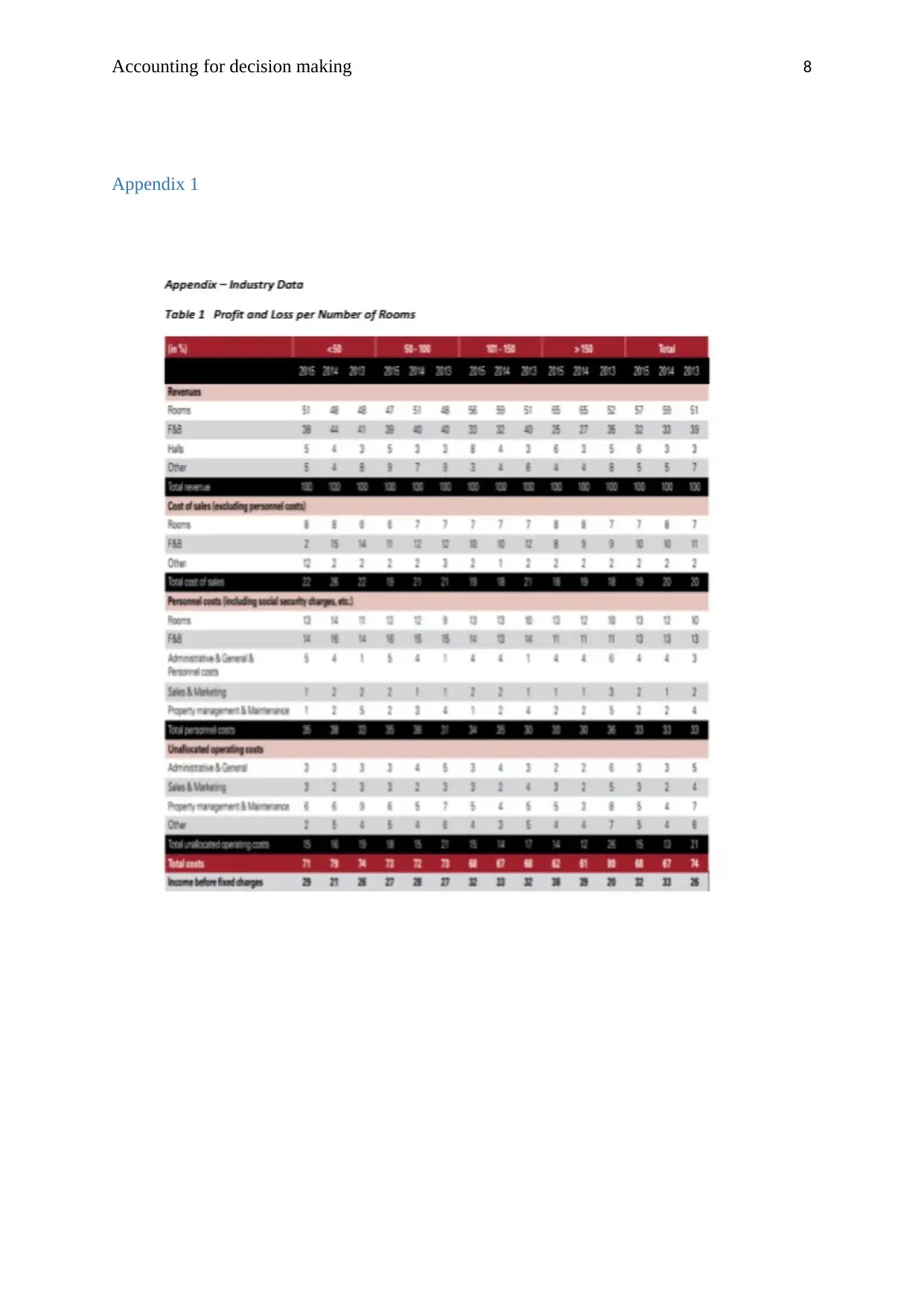
Accounting for decision making 8
Appendix 1
Appendix 1
⊘ This is a preview!⊘
Do you want full access?
Subscribe today to unlock all pages.

Trusted by 1+ million students worldwide
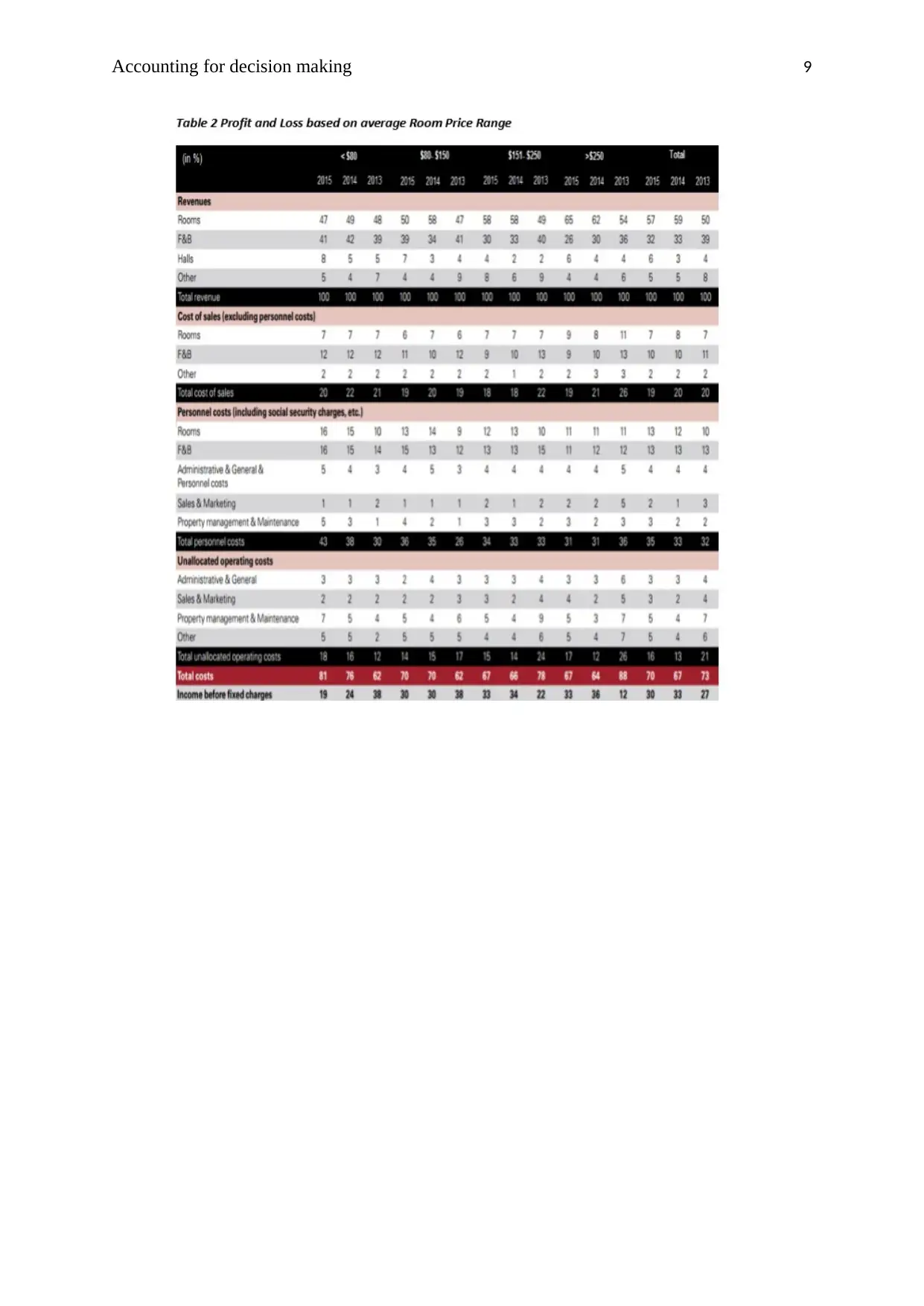
Accounting for decision making 9
1 out of 10
Related Documents
Your All-in-One AI-Powered Toolkit for Academic Success.
+13062052269
info@desklib.com
Available 24*7 on WhatsApp / Email
![[object Object]](/_next/static/media/star-bottom.7253800d.svg)
Unlock your academic potential
Copyright © 2020–2025 A2Z Services. All Rights Reserved. Developed and managed by ZUCOL.




